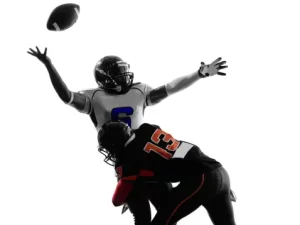In the game of football, defensive players are constantly seeking ways to stop the opposing team’s offense.
One such method is a sack. A sack occurs when a defender tackles the quarterback behind the line of scrimmage while they are holding the ball.
This action results in a loss of down and yardage for the offensive team, making it a key defensive accomplishment. However, there are instances where more than one defender plays a role in bringing down the quarterback.
In these cases, the term “half-sack” comes into play.
What is Half a Sack in Football?
A half-sack is credited to each player involved in such a tackle, illustrating their collaborative effort in disrupting the offense.
This concept is not limited to just two players – even if three defenders combine to tackle the quarterback, they all get attributed with a half-sack.
This brief introduction to half-sacks sheds light on an essential aspect of football defense strategies.
Contents
What Is a Sack in Football
A sack in football is a defensive play where a defender tackles the quarterback behind the line of scrimmage while the quarterback is holding the ball. Typically, sacks result in a loss of down and yardage for the offense. Sacks disrupt the rhythm of the offense and can lead to significant setbacks.
There are certain rules and regulations that determine whether a sack is valid:
- The quarterback must be in or out of the pocket during a passing play
- The play is not considered a sack if the quarterback intentionally grounds the ball to avoid being tackled
In summary, sacks play a crucial role in disrupting the opposing team’s offensive momentum. Understanding the concept of a sack, and its variation – the half-sack, is essential in appreciating the strategic aspect of defensive football tactics.
Understanding Half a Sack
A half-sack in football occurs when multiple players collaborate to sack the quarterback.
The quarterback is considered sacked when a defender tackles him behind the line of scrimmage while he’s in possession of the ball. Sacks typically result in a loss of down and yardage.
There are some important rules and regulations to be aware of during a sack attempt:
- Quarterbacks are eligible to be sacked when they are inside or outside the pocket during a passing play.
- Players must avoid unnecessary roughness or engaging in prohibited activities, such as helmet-to-helmet contact.
- Defensive players should be cautious not to incur a penalty for tackling too aggressively, as this could negate the sack.
In conclusion, understanding the concept of a half sack in football is important for recognizing the teamwork and skill showcased by the defensive players involved in the play.
Recording Sacks and Half Sacks in Football
In football, sacks are an essential statistic used to measure a defensive player’s impact on the game.
A sack occurs when a defensive player tackles the quarterback before they can complete a pass. Sacks can effectively disrupt an offensive drive and potentially put an offense in a more challenging situation for the next play.
To provide a clearer picture, consider the following:
- Full sack: One defensive player takes down the quarterback.
- Half sack: Combination of multiple defensive players taking down the quarterback.
It is essential to note that half-sacks do not affect the team’s overall sack count.
When calculating team sacks, each tackle of the quarterback as a passer adds one sack to the team’s total.
Here’s an example of recording sacks and half sacks:
- Player A records 1.5 sacks, which means they have one full sack and one shared sack with another player.
- Player B records 2.5 sacks, which means they have two full sacks and one shared sack with Player A.
- The team overall has combined 3 full sacks, calculated from Player A and Player B’s efforts.
In conclusion, understanding the distinction between full-sacks and half-sacks is vital in analyzing a player’s performance in football.
By accurately recording these statistics, we can better evaluate the impact of individual defensive players and the effectiveness of the team’s overall defensive strategy.
Famous NFL Players with Half Sacks
Half sacks in football occur when multiple players collaborate in bringing down a quarterback.
Terrell Suggs is one of the most renowned players in this regard. Suggs, a former Baltimore Ravens linebacker, has tallied an impressive 139 sacks during his career, including several half sacks. As a two-time Super Bowl champion, his skill and tenacity on the field have played a key role in the team’s overall success.
Another player worth mentioning is Von Miller of the Denver Broncos. As an integral part of the team, Miller has accumulated over 106 sacks in his career, with a number of half sacks as well. His remarkable performance and ability to work with his teammates have contributed to his achievements, including a Super Bowl ring.
Didn’t take long for Von Miller to get his first sack with the @BuffaloBills 🔥
(via @NFL) pic.twitter.com/LqTfw8aHBM
— FOX Sports: NFL (@NFLonFOX) September 9, 2022
Although not primarily known for this aspect of gameplay, Jamal Adams, a strong safety, has also showcased his capabilities in registering half sacks. During the 2019 season, he accumulated 6.5 sacks and ranked 52nd in the entire NFL. His versatility and skill set make him an interesting player to watch.
Jamal Adams with his first sack in a @seahawks uniform. @prez
📺: #SEAvsATL on FOX
📱: NFL app // Yahoo Sports app: https://t.co/DTlgEUZamw pic.twitter.com/DMcy1RQvdW— NFL (@NFL) September 13, 2020
Logan Ryan, a cornerback, is another example of a player making meaningful contributions with half-sacks.
In the 2019 season, he amassed 4.5 sacks, demonstrating his ability to also contribute defensively. His adaptability and prowess on the field have earned him recognition among his peers.
These are just a few examples of famous NFL players who have garnered half-sacks over their careers. Their talent and teamwork have allowed them to cement their status as elite athletes, making significant impacts on their respective teams’ performances.
Impact of Half Sacks on Game Strategy
.Creating a stronger pass rush by striving for half sacks can be achieved through different approaches:
- Blitzing: Sending additional defensive players to rush the passer, increasing the odds of a sack.
- Stunts: Implementing planned movements by defensive linemen to create confusion among the offensive line and open up gaps for pass rushers.
- Zone pressure: Combining zone coverage schemes with blitzes to pressure the quarterback while maintaining coverage in the secondary.
The impact of half-sacks extends beyond disrupting individual plays. Consistent pressure on the quarterback can lead to rushed decisions, resulting in interceptions or incomplete passes, ultimately shifting the momentum in favor of the defensive team.
In summary, incorporating half sacks into a game strategy offers teams an opportunity to exploit weaknesses in the opponent’s offense, creating more favorable situations for the defense.



